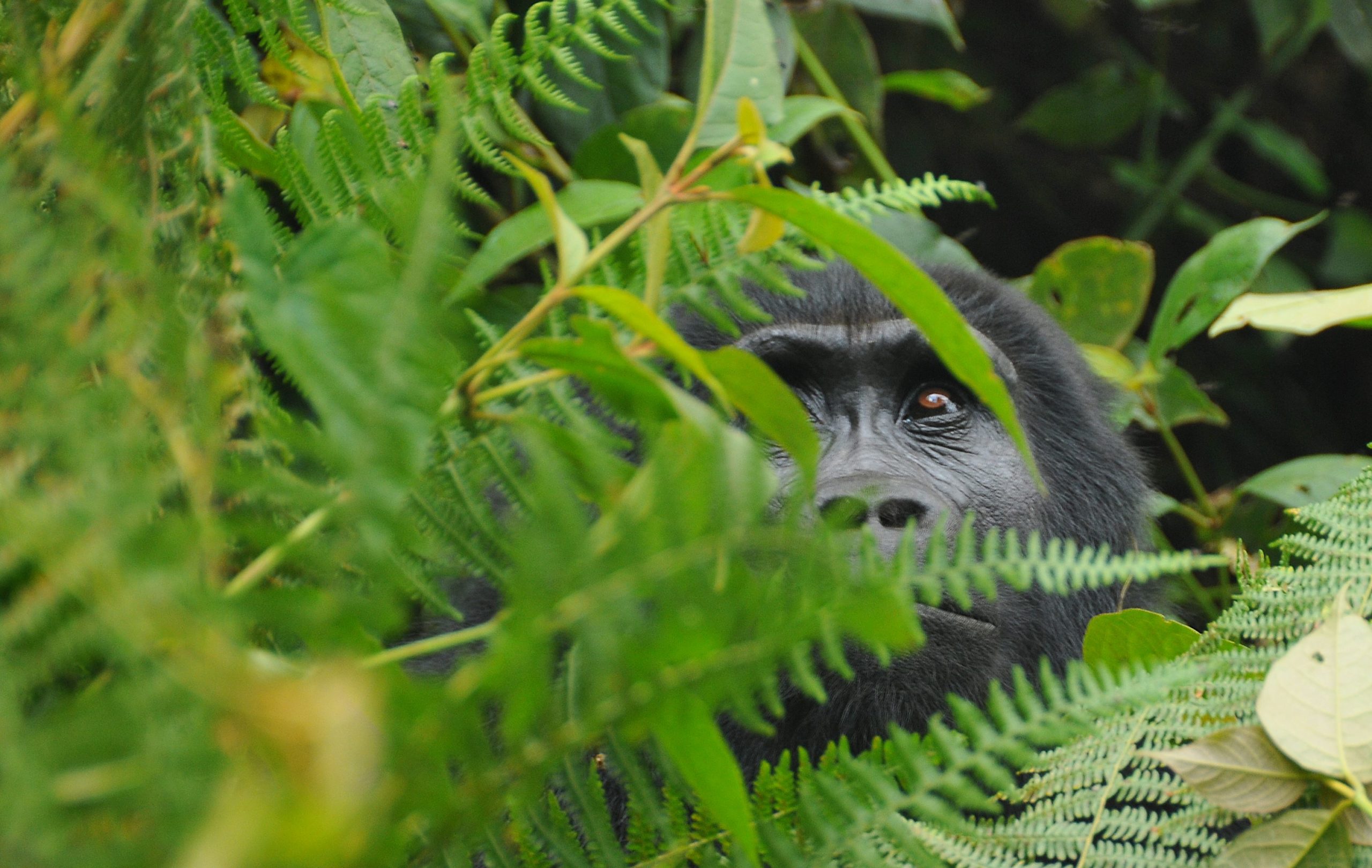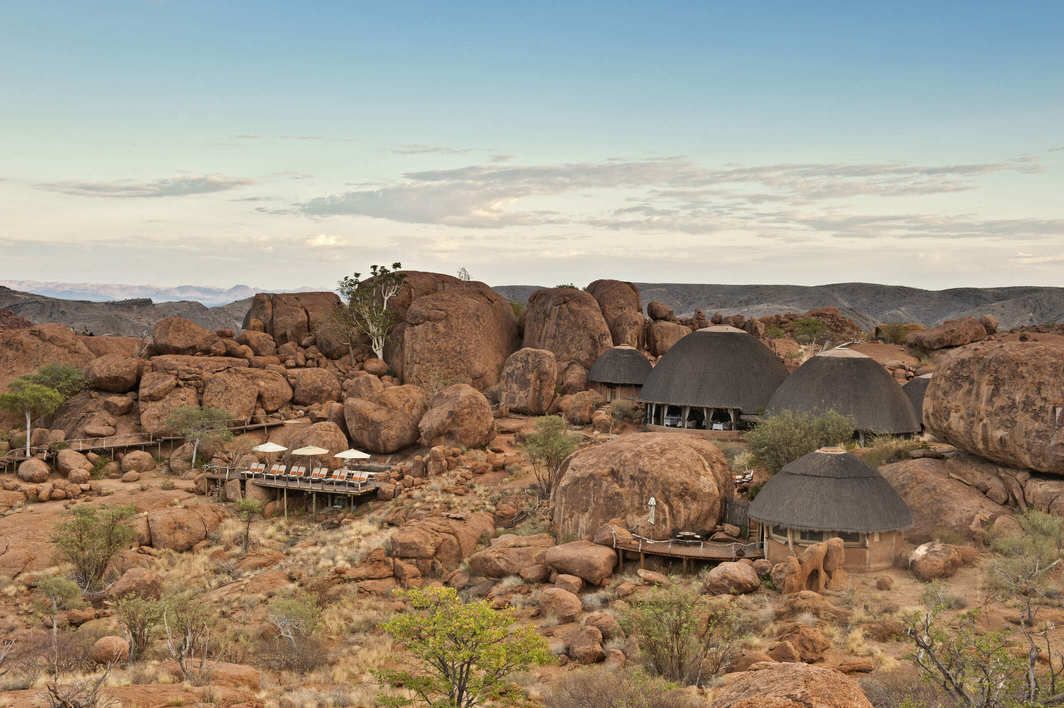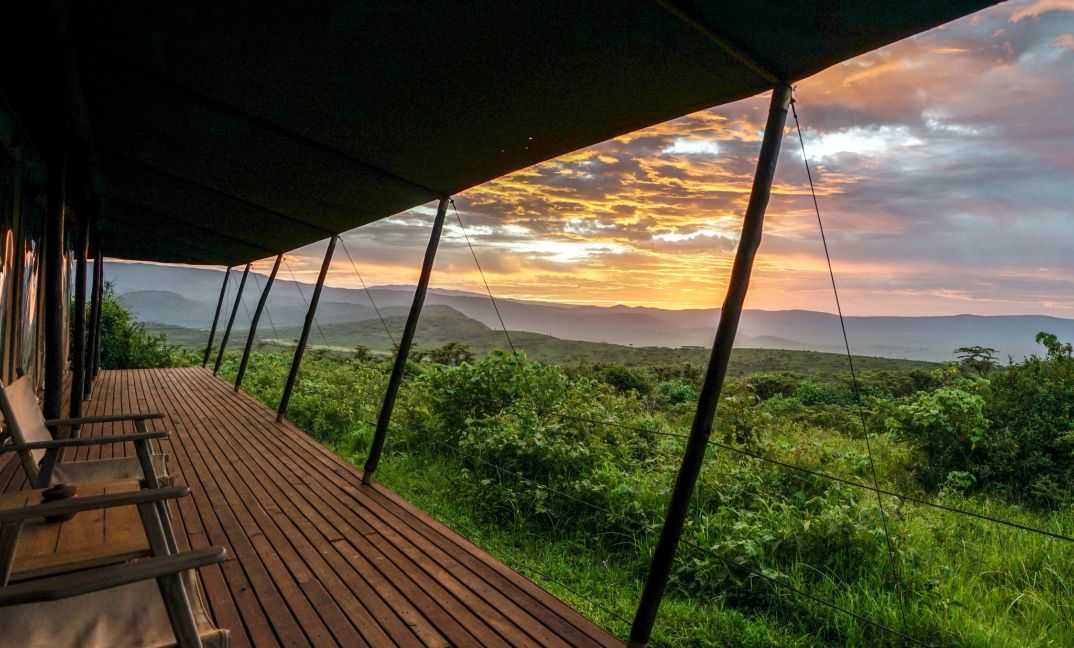Tracking gorillas in the wild is a magical experience. Many of our clients have lots of questions about practicalities. I was lucky enough to visit the Mucunguzi gorilla family in the Rushaga sector of Bwindi Impenetrable Forest in Uganda in August 2019 and these are my top tips for preparing for your visit.
Permits are strictly limited and so it is a good idea to plan ahead and to book a gorilla trekking package with your tour operator well in advance. At time of writing permits in Uganda were half the price of permits in Rwanda. Many people say that you trek further in Uganda – in Rwanda the gorilla families tend to stay closer to the park HQ so this may be something to consider if you are concerned about distance/stamina.
What to wear:
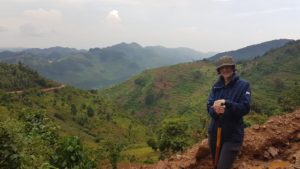 Dress for all seasons – go for layers, and light breathable fabrics
Dress for all seasons – go for layers, and light breathable fabrics
Long trousers
Worn-in hiking/walking boots to handle slippery/uneven slopes
Long-sleeved top to protect against scratches/insects etc
Wide brimmed hat / cap /bandana to protect your head from the Equatorial sun
A waterproof jacket / poncho
Gardening gloves – to protect hands from stings/scratches in the forest
Some people wear gators to ward against ants but in Uganda this really is not necessary
What to take with you:
A photocopy of your passport – the rangers ask for this on arrival at the briefing so they can allocate everyone into groups using age as a guide where possible.
Daypack
Your camera and any spare batteries/your phone
Waterproofing for your bag /dry bag for camera equipment – essential!
Plenty of fresh drinking water – 2-3 litres recommended
Snacks (your lodge will provide a basic picnic lunch)
Sunscreen/insect repellent/lip balm/hand sanitiser as needed
Face masks may become compulsory for gorilla visits following the pandemic – please check before departure
Cash – you can hire a porter at the start point for approx $15 USD cash to carry your backpack and look after it while you are with the gorillas – this service supports the local community and is recommended even if you don’t feel like you need the help. Tips for the trackers/guide are greatly appreciated. These are discretionary and given at the end – budget around $15-$20 for the head guide and $5-$10 for each tracker (per person trekking).
The briefing:
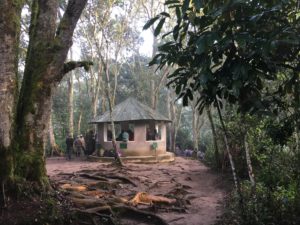 There was a short 10 minute uphill walk into the forest to the briefing centre.
There was a short 10 minute uphill walk into the forest to the briefing centre.
The head guide ran through the history of the park, some basic rules and what to expect from the experience. He covered health and safety issues and practical issues such as how long will the walk be (usually 2-6 hours in total), how long do we spend with the gorillas (60 minutes), where can you go to the loo (at the park HQ and trek start points) and how rest stops work (guides will govern rest stops).
All the guides stand with a sign with the name of a gorilla family on. Once you have been told which gorilla family you have been allocated, you go and find your guide. There are walking sticks which you can borrow for the duration of the trek – these really help if rain is expected and the path is slippery.
Approximate timings (based on my gorilla trekking experience)
We left the lodge about 7am
The briefing ran from 745/8am – to around 830/845am
We then walked back to the vehicle and travelled to the start point which was in a village about 30 minutes drive away
We started trekking about 930am.
We got to the gorillas about midday, left at 1pm, and we were back at the lodge by about 4/4.30pm that afternoon.
The trek:
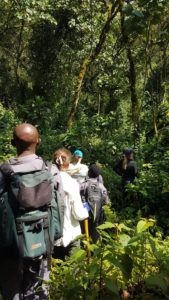 How long or arduous the trek is depends on where your gorilla family is foraging in the forest
How long or arduous the trek is depends on where your gorilla family is foraging in the forest
Our trek was approx. 15km round trip / 2 hour 30 minutes walking each direction roughly including stops
Some groups do not have to trek far at all and others will be gone all day.
Some groups set off immediately from the briefing point – our group had to be transported to a nearby village (about 30 minutes away) where we then began our trek from a small café.
Groups comprise a maximum of 8-10 people plus a couple of trackers and a head guide.
Our trek went uphill out of the village on a rough stony/muddy road for about an hour initially with beautiful views over the forest. It was very hot walking in the morning sun. Coming from sea level living, the altitude of 2850m had an impact and I found I could not walk at the same sustained pace as the guides with their long legs – it was better to go slow and steady. The guides do stop at various points so everyone can catch up, have a drink and re-group.
For the second hour trekking we moved off the village road into the forest itself. Before entering the forest we put on long sleeve tops and gloves. The path was undulating (not all uphill…) and very muddy and steep in a couple of places, and the vegetation was incredibly dense. The birds were amazing, and we also saw forest elephant tracks. It was magical to be in the forest. You could hear the trackers up ahead calling to the gorillas.
Time with gorillas:
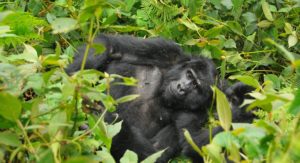 When we arrived near the gorillas, the guide asked us to be quiet and to leave all our bags with the porters, just taking cameras with us.
When we arrived near the gorillas, the guide asked us to be quiet and to leave all our bags with the porters, just taking cameras with us.
The silverback Mucunguzi sat just metres away from us in a small clearing on a slope. This was the best view I got of the silverback – I didn’t have my camera out of my bag, so I just enjoyed the moment. Seeing all of us, Mucunguzi then got up and slumped back down in the middle of a thicket – this is where he stayed!
The guides led us over closer to Mucunguzi who was now well concealed in the bush. It was quite steep and uneven with lots of nettles so you couldn’t all be in prime position. The guides work hard to ensure everyone gets a chance to be at the front at some pont during the 60 minutes.
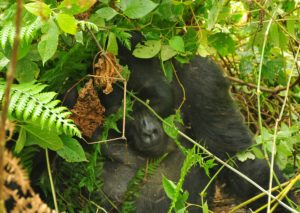 The Mucunguzi family comprised 8 members – the young gorillas were jumping around in the boughs of a low tree very near us, and a mother and young gorilla were grooming further up the steep slope. The other members of the family were audible but could not be seen in the vegetation. The guides showed us the best way to approach and used pangas to slash some of the undergrowth and provide a more stable footing for us. A couple of gorillas barrelled down the slope right at us, so we had to move quickly to get out of the way.
The Mucunguzi family comprised 8 members – the young gorillas were jumping around in the boughs of a low tree very near us, and a mother and young gorilla were grooming further up the steep slope. The other members of the family were audible but could not be seen in the vegetation. The guides showed us the best way to approach and used pangas to slash some of the undergrowth and provide a more stable footing for us. A couple of gorillas barrelled down the slope right at us, so we had to move quickly to get out of the way.
We were given a 5-minute warning before we had to depart.
The 60 minutes tick away very quickly and undoubtedly the most magical moments were those when I put my camera down and just enjoyed the interactions.
The return trek:
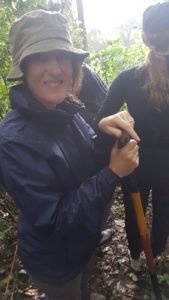 You follow roughly the same path back to the village.
You follow roughly the same path back to the village.
The moment we left the gorillas, the heavens opened, and we had a torrential downpour which lasted about 2 hours! This made the trekking quite challenging. There were rivers running down the hillside and it was incredibly slippery. We did stop to eat our picnic lunch for about 10 minutes under some dense foliage in the middle of the forest. The noise of the rain in the forest was amazing.
The sun came out as we reached the village. Everyone had huge clods of mud stuck to their boots!
We were presented with certificates and then met our drivers to return to our respective lodges.
Back at the lodge:
The staff had lit fires in our rooms for us. We had hot cups of tea and biscuits and then showers before supper. If you leave your boots outside your room, the staff will take them away for cleaning. I think this is fairly universal service at gorilla trekking lodges. I found my boots next morning looking much cleaner. I put my kit by the fire to dry but it was still damp the next day so make sure you have alternative footwear/clothing and bags to pack away your damp kit.
